Food
Trans Fat Now Listed With Saturated Fat and Cholesterol
Read the Disclaimer
On this page:
- Trans Fat Coming to a Label Near You!
- What is Trans Fat?
- Are All Fats the Same?
- What Can I Do About Saturated Fat, Trans Fat, and Cholesterol?
- Where Can I Find Trans Fat on the Food Label?
- Why Do Some Products Not Declare Trans Fat on Their Labels?
- How Do Your Choices Stack Up?
- How Can I Use the Label to Make Heart-Healthy Food Choices?
- Do Dietary Supplements Contain Trans Fat?
- Practical Tips for Consumers!
- Need More Information?
Trans Fat Coming to a Label Near You!
The Food and Drug Administration (FDA) now requires food manufacturers to list trans fat (i.e., trans fatty acids) on Nutrition Facts and some Supplement Facts panels. Scientific evidence shows that consumption of saturated fat, trans fat, and dietary cholesterol raises low-density lipoprotein (LDL or "bad") cholesterol levels that increase the risk of coronary heart disease (CHD). According to the National Heart, Lung, and Blood Institute of the National Institutes of Health, over 12.5 million Americans suffer from CHD, and more than 500,000 die each year. This makes CHD one of the leading causes of death in the United States today.
FDA has required that saturated fat and dietary cholesterol be listed on the food label since 1993. By adding trans fat on the Nutrition Facts panel (required by January 1, 2006), consumers now know for the first time how much of all three -- saturated fat, trans fat, and cholesterol -- are in the foods they choose. Identifying saturated fat, trans fat, and cholesterol on the food label gives consumers information to make heart-healthy food choices that help them reduce their risk of CHD. This revised label, which includes information on trans fat as well as saturated fat and cholesterol, will be of particular interest to people concerned about high blood cholesterol and heart disease. However, all Americans should be aware of the risk posed by consuming too much saturated fat, trans fat, and cholesterol. But what is trans fat, and how can you limit the amount of this fat in your diet?
What is Trans Fat? Where will I find trans fat?
Vegetable shortenings, some margarines, crackers, cookies, snack foods, and other foods made with or fried in partially hydrogenated oils.
Unlike other fats, the majority of trans fat is formed when liquid oils are made into solid fats like shortening and hard margarine. However, a small amount of trans fat is found naturally, primarily in some animal-based foods. Essentially, trans fat is made when hydrogen is added to vegetable oil -- a process called hydrogenation. Hydrogenation increases the shelf life and flavor stability of foods containing these fats.
Trans fat, like saturated fat and dietary cholesterol, raises the LDL (or "bad") cholesterol that increases your risk for CHD. On average, Americans consume 4 to 5 times as much saturated fat as trans fat in their diet.
Although saturated fat is the main dietary culprit that raises LDL, trans fat and dietary cholesterol also contribute significantly. Trans fat can often be found in processed foods made with partially hydrogenated vegetable oils such as vegetable shortenings, some margarines (especially margarines that are harder), crackers, candies, cookies, snack foods, fried foods, and baked goods.
Are All Fats the Same?
Simply put: no. Fat is a major source of energy for the body and aids in the absorption of vitamins A, D, E, and K, and carotenoids. Both animal and plant-derived food products contain fat, and when eaten in moderation, fat is important for proper growth, development, and maintenance of good health. As a food ingredient, fat provides taste, consistency, and stability and helps us feel full. In addition, parents should be aware that fats are an especially important source of calories and nutrients for infants and toddlers (up to 2 years of age), who have the highest energy needs per unit of body weight of any age group.
Saturated and trans fats raise LDL (or "bad") cholesterol levels in the blood, thereby increasing the risk of heart disease. Dietary cholesterol also contributes to heart disease. Unsaturated fats, such as monounsaturated and polyunsaturated, do not raise LDL cholesterol and are beneficial when consumed in moderation. Therefore, it is advisable to choose foods low in saturated fat, trans fat, and cholesterol as part of a healthful diet.
What Can I Do About Saturated Fat, Trans Fat, and Cholesterol?
When comparing foods, look at the Nutrition Facts panel, and choose the food with the lower amounts of saturated fat, trans fat, and cholesterol. Health experts recommend that you keep your intake of these nutrients as low as possible while consuming a nutritionally adequate diet. However, these experts recognize that eliminating these three components entirely from your diet is not practical because they are unavoidable in ordinary diets.
Where Can I Find Trans Fat on the Food Label?
Take a look at the Nutrition Facts panel at the top of this page. Consumers can find trans fat listed on the Nutrition Facts panel directly under the line for saturated fat.
Why Do Some Products Not Declare Trans Fat On Their Labels?
There may be two reasons why you are not seeing trans fat on a product's label.
First, products entering interstate commerce on or after January 1, 2006 must be labeled with trans fat. As this is happening, FDA realizes that it will take some time for food products to move through the distribution chain to a store shelf. Thus, it may take a few months for products that are listing trans fat on their label to show up on a store shelf. However, you will see many products with trans fat listed since companies have already begun to declare trans fat on their products' labels.
Second, FDA has granted enforcement discretion to some firms to use old label stock that do not declare trans fat after the effective date of January 1, 2006. In these cases, food firms followed the required process described in FDA's Guidance for Industry and FDA: Requesting an Extension to Use Existing Label Stock after the Trans Fat Labeling Effective Date of January 1, 2006 (Revised)." For each request, FDA is considering whether the declared label value for trans fat is 0.5 g or less per serving. This information is important because lower amounts of trans fat would have less impact on public health than higher amounts of trans fat. Thus, trans fat information in the Nutrition Facts panel will be missing on some products (that contain lower amounts of trans fat) throughout the next year.
If trans fat is not declared on the label and you are curious about the trans fat content of a product, contact the manufacturer listed on the label.
How Do Your Choices Stack Up?
With the addition of trans fat to the Nutrition Facts panel, you can review your food choices and see how they stack up. The following labels illustrate total fat, saturated fat, trans fat, and cholesterol content per serving for selected food products.
Don't assume similar products are the same. Be sure to check the Nutrition Facts panel (NFP) when comparing products because even similar foods can vary in calories, ingredients, nutrients, and the size and number of servings in the package. When buying the same brand product, also check the NFP frequently because ingredients can change at any time and any change could affect the NFP information.
Look at the highlighted items on the sample labels below. Combine the grams (g) of saturated fat and trans fat and look for the lowest combined amount. Also, look for the lowest percent (%) Daily Value for cholesterol. Check all three nutrients to make the best choice for a healthful diet.
Note: The following label examples do not represent a single product or an entire product category. In general, the nutrient values were combined for several products and the average values were used for these label examples.
| Butter ** | Margarine, stick † | Margarine, tub † |
|---|---|---|
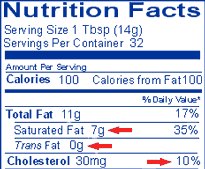 | 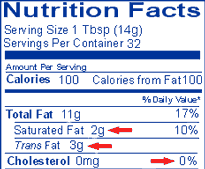 | 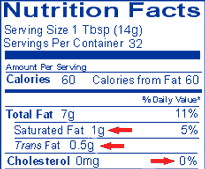 |
| Saturated Fat : 7g + Trans Fat : 0g Combined Amt.: 7g | Saturated Fat : 2g + Trans Fat : 3g Combined Amt.: 5g | Saturated Fat : 1 g + Trans Fat : 0.5g Combined Amt.: 1.5g |
| Cholesterol: 10 % DV | Cholesterol: 0 % DV | Cholesterol: 0 % DV |
| *Nutrient values rounded based on FDA's nutrition labeling regulations. Calorie and cholesterol content estimated. **Butter values from FDA Table of Trans Values, 1/30/95. † Values derived from 2002 USDA National Nutrient Database for Standard Reference, Release 15. | ||
| Granola Bar ± | Sandwich Cookies ± | Cake, Iced and Filled ± |
|---|---|---|
 | 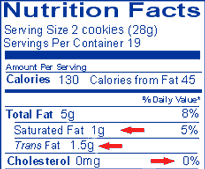 | 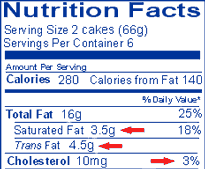 |
| Saturated Fat : 1 g + Trans Fat : 0 g Combined Amt.: 1 g | Saturated Fat : 1 g + Trans Fat : 1.5g Combined Amt.: 2.5g | Saturated Fat : 3.5g + Trans Fat : 4.5g Combined Amt.: 8 g |
| Cholesterol: 0 % DV | Cholesterol: 0 % DV | Cholesterol: 3 % DV |
| *Nutrient values rounded based on FDA's nutrition labeling regulations. ± Values for total fat, saturated fat, and trans fat were based on the means of analytical data for several food samples from Subramaniam, S., et al., "Trans, Saturated, and Unsaturated Fat in Foods in the United States Prior to Mandatory trans-Fat Labeling," Lipids 39, 11-18, 2004. Other information and values were derived from food labels in the marketplace. | ||
| Frozen Potatoes ± (e.g., French Fries) | Potato Chips ± | Mini-Sandwich Crackers ± |
|---|---|---|
 |  |  |
| Saturated Fat : 1 g + Trans Fat : 1.5g Combined Amt.:2.5g | Saturated Fat : 2g + Trans Fat : 0g Combined Amt.: 2g | Saturated Fat : 2g + Trans Fat : 2g Combined Amt.: 4g |
| Cholesterol: 0 % DV | Cholesterol: 0 % DV | Cholesterol: 1 % DV |
| *Nutrient values rounded based on FDA's nutrition labeling regulations. ± Values for total fat, saturated fat, and trans fat were based on the means of analytical data for several food samples from Subramaniam, S., et al., "Trans, Saturated, and Unsaturated Fat in Foods in the United States Prior to Mandatory trans-Fat Labeling," Lipids 39, 11-18, 2004. Other information and values were derived from food labels in the marketplace. | ||
How Can I Use the Label to Make Heart-Healthy Food Choices?
The Nutrition Facts panel can help you choose foods lower in saturated fat, trans fat, and cholesterol. To lower your intake of saturated fat, trans fat, and cholesterol, compare similar foods and choose the food with the lower combined saturated and trans fats and the lower amount of cholesterol.

Product | Calories | Total Fat g | Saturated Fat g | Trans Fat g | Combined Saturated and Trans Fats g | Cholesterol mg |
|---|---|---|---|---|---|---|
| Margarine, 80% fat, stick † | 100 | 11 | 2 | 3 | 5 | 0 |
| Butter ** | 100 | 11 | 7 | 0 | 7 | 30 |
| Margarine, 60% fat, tub‡ | 80 | 9 | 1.5 | 0 | 1.5 | 0 |
| Margarine, 70% fat, stick † | 90 | 10 | 2 | 2.5 | 4.5 | 0 |
*Nutrient values rounded based on FDA's nutrition labeling regulations. Calorie and cholesterol content estimated.
**Butter values from FDA Table of Trans Values, dated 1/30/95.
† Values derived from 2002 USDA National Nutrient Database for Standard Reference, Release 15.
‡ Prerelease values derived from 2003 USDA National Nutrient Database for Standard Reference,Release 16.
Answers:
Margarine, 80% fat, stick † Look for another option. This choice does not contain the lowest combined amount of Saturated and Trans Fat.
Butter ** Look for another option. This choice contains the highest combined amount of Saturated and Trans Fat, and the highest amount of Cholesterol.
Margarine, 60% fat, tub‡ Congratulations! This choice has the lowest combined amount of Saturated and Trans fat and 0 g of Cholesterol.
Margarine, 70% fat, stick † Look for another option. This choice does not contain the lowest combined amount of Saturated and Trans Fat.
Although the updated Nutrition Facts panel will now list the amount of trans fat in a product, it will not show a %Daily Value (%DV). While scientific reports have confirmed the relationship between trans fat and an increased risk of CHD, none has provided a reference value for trans fat or any other information that FDA believes is sufficient to establish a Daily Reference Value or a %DV.
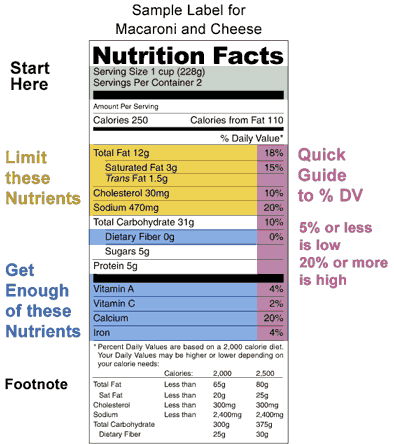
Saturated fat and cholesterol, however, do have a %DV. To choose foods low in saturated fat and cholesterol, use the Quick Guide to %DV. The general rule of thumb is: 5%DV or less is low and 20%DV or more is high.
You can also use the %DV to make dietary trade-offs with other foods throughout the day. You don't have to give up a favorite food to eat a healthy diet. When a food you like is high in saturated fat or cholesterol, balance it with foods that are low in saturated fat and cholesterol at other times of the day.
This graphic of the Nutrition Facts panel illustrates which nutrients experts recommend you limit and which they recommend you consume in adequate amounts.
Do Dietary Supplements Contain Trans Fat?
Would it surprise you to know that some dietary supplements contain trans fat from partially hydrogenated vegetable oil as well as saturated fat or cholesterol? It's true. As a result of FDA's new label requirement, if a dietary supplement contains a reportable amount of trans or saturated fat, which is 0.5 gram or more, dietary supplement manufacturers must list the amounts on the Supplement Facts panel. Some dietary supplements that may contain saturated fat, trans fat, and cholesterol include energy and nutrition bars.
Practical Tips for Consumers!
Here are some practical tips you can use every day to keep your consumption of saturated fat, trans fat, and cholesterol low while consuming a nutritionally adequate diet.
- Check the Nutrition Facts panel to compare foods because the serving sizes are generally consistent in similar types of foods. Choose foods lower in saturated fat, trans fat, and cholesterol. For saturated fat and cholesterol, use the Quick Guide to %DV: 5%DV or less is low and 20%DV or more is high. (Remember, there is no %DV for trans fat.)
- Choose Alternative Fats. Replace saturated and trans fats in your diet with mono- and polyunsaturated fats. These fats do not raise LDL (or "bad") cholesterol levels and have health benefits when eaten in moderation.
Sources of monounsaturated fats include olive and canola oils.
Sources of polyunsaturated fats include soybean oil, corn oil, sunflower oil and foods like nuts and fish.
- Choose vegetable oils (except coconut and palm kernel oils) and soft margarines (liquid, tub, or spray) more often because the amounts of saturated fat, trans fat, and cholesterol are lower than the amounts in solid shortenings, hard margarines, and animal fats, including butter.
- Consider Fish. Most fish are lower in saturated fat than meat. Some fish, such as mackerel, sardines, and salmon, contain omega-3 fatty acids that are being studied to determine if they offer protection against heart disease.
- Choose Lean Meats, such as poultry (without skin, not fried), lean beef and pork (trim visible fat, not fried).
- Ask Before You Order When Eating Out. A good tip to remember is to ask which fats are being used in the preparation of your food when eating or ordering out.
- Watch Calories. Don't be fooled! Fats are high in calories. All sources of fat contain 9 calories per gram, making fat the most concentrated source of calories. By comparison, carbohydrates and protein have only 4 calories per gram.
- Here are two actions consumers can take to keep their intake of saturated fat, trans fat, and cholesterol "low":
- Look at the Nutrition Facts panel when comparing products. Choose foods low in the combined amount of saturated fat and trans fat and low in cholesterol as part of a nutritionally adequate diet.
- When possible, substitute alternative fats that are higher in mono- and polyunsaturated fats like olive oil, canola oil, soybean oil, sunflower oil and corn oil.
Need More Information?
- Advance Notice of Proposed Rulemaking: Trans Fatty Acids in Nutrition Labeling; Consumer Research to Consider Nutrient Content and Health Claims and Possible Footnote or Disclosure Statements
Disclaimer: FDA is issuing this document as general information for the public. FDA intends this document to aid the public in understanding how to use the declaration of trans fatty acids in the nutrition label of conventional foods and dietary supplements.







